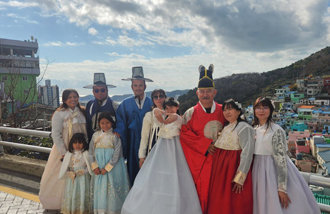[Opinion] Nuclear Bag
Americans dropped two different kinds of atomic bombs down to Japan in 1945. They dropped a uranium bomb nicknamed the `little boy` down to Hiroshima on August 6 before sending a plutonium bomb called the `fat man` to Nagasaki two days later. The fat man, installed with 6kg of plutonium, had only 17% of efficiency, and the little boy with 60kg of enriched uranium had mere 1.3%. Efficiency means the magnitude of destruction caused by complete explosion of a nuclear bomb. Despite the low efficiency, the sky over the two cities was covered with mushroom cloud sprawling several kilometer. The world`s first nuclear bombs were very heavy, too. The B-29 bomber was the only aircraft big enough to carry the fat man and the little boy, which weighed 4,900kg and 4,000kg respectively.
Since then, scientists across the world have been working hard to boost efficiency and reduce the size of nuclear bombs. A variety of delivery systems have also been developed. Apart from the traditional systems of missiles and airdrop, nuclear shells, torpedoes, mines and bags were introduced. A nuclear bag, which was temporarily deployed in the Korean peninsula in the 1980s before removed under the direction of then U.S. president George Bush, is one of the smallest nuclear weapons systems. It weighs only about 30kg and is portable. With the advance of nuclear development technology, one day we might see a nuclear bullet fired by a rifle.
Until the mid 1990s, it was believed that North Korea did not have a small nuclear warhead that is mountable to a missile. Experts at that time jokingly said that North Koreans needed to load their nuclear bomb in a large truck and drive it to the target position before exploding it. The New York Times, however, reported a few days ago that North Koreans might be developing a small nuclear warhead, causing concern for their nuclear capabilities. Prof. Shin Sung-taek at the Korea Institute of Defense said that the development of a small nuclear warhead is very likely, citing that North Korea might have reduced the size and weight of nuclear weapons by leveraging their advanced explosive device technology; nuclear weapons are now made up of titanium instead of steel; and trigger systems have also been evolved.
What will happen if North Korea has a nuclear missile at their hand? The U.S. and Japan will not let North Koreans have their nuclear system. Supporters of a `preemptive attack` will raise their voice – even the relatively dovish Clinton administration considered bombing the nuclear facilities in Youngbyeon in 1994. Japan might make fast moves to develop their own nuclear weapons, triggering China to follow suit. South Korea will likely become a captive of North Korean nuclear missile. The image of such future is horrifying, indeed.
songmh@donga.com
Headline News
- Trump’s proposed tariffs on Mexico, Canada, and China spark global trade concerns
- Samsung C&T and partners secure 5.2 trillion won Qatar plant order
- Seoul launches early-morning autonomous bus service
- Kiwoom Heroes signs with outfielder Yasiel Puig
- Lee acquitted of subornation of perjury charges in first trial







